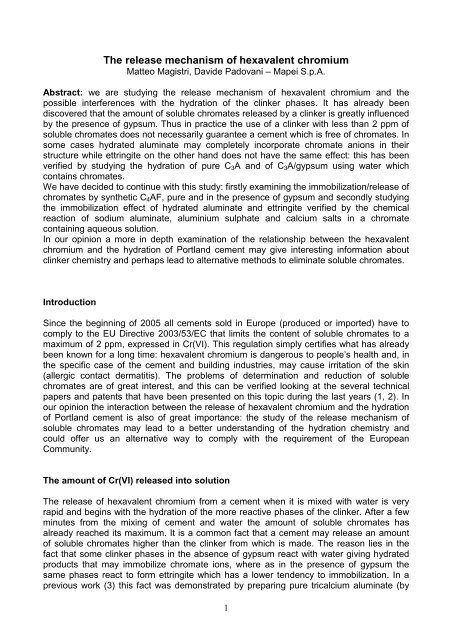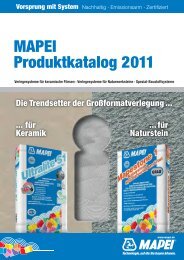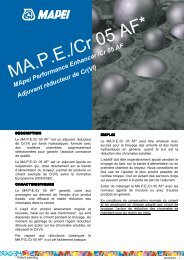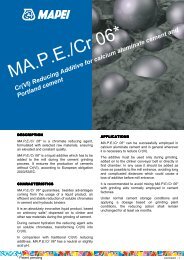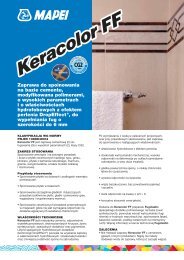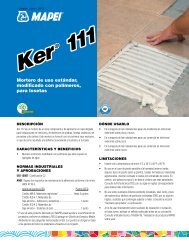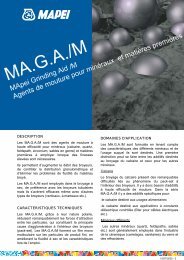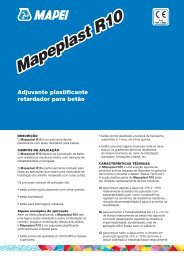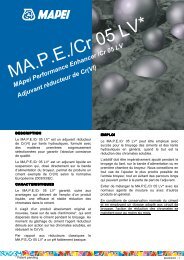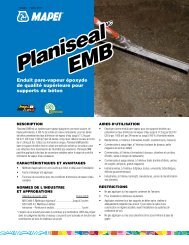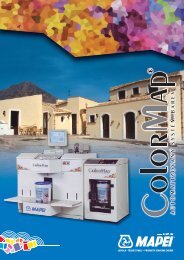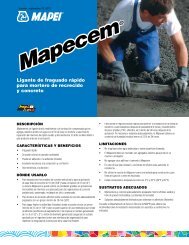The release mechanism of hexavalent chromium - Mapei
The release mechanism of hexavalent chromium - Mapei
The release mechanism of hexavalent chromium - Mapei
Create successful ePaper yourself
Turn your PDF publications into a flip-book with our unique Google optimized e-Paper software.
<strong>The</strong> <strong>release</strong> <strong>mechanism</strong> <strong>of</strong> <strong>hexavalent</strong> <strong>chromium</strong>Matteo Magistri, Davide Padovani – <strong>Mapei</strong> S.p.A.Abstract: we are studying the <strong>release</strong> <strong>mechanism</strong> <strong>of</strong> <strong>hexavalent</strong> <strong>chromium</strong> and thepossible interferences with the hydration <strong>of</strong> the clinker phases. It has already beendiscovered that the amount <strong>of</strong> soluble chromates <strong>release</strong>d by a clinker is greatly influencedby the presence <strong>of</strong> gypsum. Thus in practice the use <strong>of</strong> a clinker with less than 2 ppm <strong>of</strong>soluble chromates does not necessarily guarantee a cement which is free <strong>of</strong> chromates. Insome cases hydrated aluminate may completely incorporate chromate anions in theirstructure while ettringite on the other hand does not have the same effect: this has beenverified by studying the hydration <strong>of</strong> pure C 3 A and <strong>of</strong> C 3 A/gypsum using water whichcontains chromates.We have decided to continue with this study: firstly examining the immobilization/<strong>release</strong> <strong>of</strong>chromates by synthetic C 4 AF, pure and in the presence <strong>of</strong> gypsum and secondly studyingthe immobilization effect <strong>of</strong> hydrated aluminate and ettringite verified by the chemicalreaction <strong>of</strong> sodium aluminate, aluminium sulphate and calcium salts in a chromatecontaining aqueous solution.In our opinion a more in depth examination <strong>of</strong> the relationship between the <strong>hexavalent</strong><strong>chromium</strong> and the hydration <strong>of</strong> Portland cement may give interesting information aboutclinker chemistry and perhaps lead to alternative methods to eliminate soluble chromates.IntroductionSince the beginning <strong>of</strong> 2005 all cements sold in Europe (produced or imported) have tocomply to the EU Directive 2003/53/EC that limits the content <strong>of</strong> soluble chromates to amaximum <strong>of</strong> 2 ppm, expressed in Cr(VI). This regulation simply certifies what has alreadybeen known for a long time: <strong>hexavalent</strong> <strong>chromium</strong> is dangerous to people’s health and, inthe specific case <strong>of</strong> the cement and building industries, may cause irritation <strong>of</strong> the skin(allergic contact dermatitis). <strong>The</strong> problems <strong>of</strong> determination and reduction <strong>of</strong> solublechromates are <strong>of</strong> great interest, and this can be verified looking at the several technicalpapers and patents that have been presented on this topic during the last years (1, 2). Inour opinion the interaction between the <strong>release</strong> <strong>of</strong> <strong>hexavalent</strong> <strong>chromium</strong> and the hydration<strong>of</strong> Portland cement is also <strong>of</strong> great importance: the study <strong>of</strong> the <strong>release</strong> <strong>mechanism</strong> <strong>of</strong>soluble chromates may lead to a better understanding <strong>of</strong> the hydration chemistry andcould <strong>of</strong>fer us an alternative way to comply with the requirement <strong>of</strong> the EuropeanCommunity.<strong>The</strong> amount <strong>of</strong> Cr(VI) <strong>release</strong>d into solution<strong>The</strong> <strong>release</strong> <strong>of</strong> <strong>hexavalent</strong> <strong>chromium</strong> from a cement when it is mixed with water is veryrapid and begins with the hydration <strong>of</strong> the more reactive phases <strong>of</strong> the clinker. After a fewminutes from the mixing <strong>of</strong> cement and water the amount <strong>of</strong> soluble chromates hasalready reached its maximum. It is a common fact that a cement may <strong>release</strong> an amount<strong>of</strong> soluble chromates higher than the clinker from which is made. <strong>The</strong> reason lies in thefact that some clinker phases in the absence <strong>of</strong> gypsum react with water giving hydratedproducts that may immobilize chromate ions, where as in the presence <strong>of</strong> gypsum thesame phases react to form ettringite which has a lower tendency to immobilization. In aprevious work (3) this fact was demonstrated by preparing pure tricalcium aluminate (by1
heating a mixture <strong>of</strong> lime and alumina) that was hydrated with water containing <strong>hexavalent</strong><strong>chromium</strong>. By filtering <strong>of</strong>f the water, it was possible to verify that all the <strong>chromium</strong>disappeared from the solution and was captured in the hydration products. In the sameway, after the hydration <strong>of</strong> a mixture <strong>of</strong> C 3 A and gypsum with water containing chromates,it was demonstrated that the hydration products <strong>of</strong> tricalcium aluminate in the presence <strong>of</strong>gypsum were unable to immobilize the same amount <strong>of</strong> <strong>chromium</strong>.Aluminates hydration effect on Cr(VI) <strong>release</strong>We decided to carry on with this work and report here the results obtained after trialsperformed with the following targets:- verify the effect <strong>of</strong> tetracalcium allumin<strong>of</strong>errite on the immobilization <strong>of</strong> chromates;- verify the reversibility <strong>of</strong> the immobilization <strong>of</strong> chromates by hydrated aluminates;- study in detail the <strong>mechanism</strong> <strong>of</strong> chromates immobilization.It is well known that in Portland clinker there are two main phases based on aluminium andcharacterized by instantaneous reactivity with water: tricalcium aluminate (C 3 A) andtetracalcium alumin<strong>of</strong>errite (C 4 AF). It is possible to prepare pure C 4 AF by heating a mixture<strong>of</strong> analytical grade CaO, Al 2 O 3 and Fe 2 O 3 in appropriate amounts to 1300°C. <strong>The</strong> product<strong>of</strong> the reaction is then ground (totally passing through a 90 micron sieve) andcharacterized by X-ray diffraction.Following the procedure already used for the tricalcium aluminate (see ref. 3) half <strong>of</strong> thetetracalcium alumin<strong>of</strong>errite was hydrated in water containing chromates. <strong>The</strong> second halfwas mixed with gypsum and then hydrated in the same water as reported in the table 1.TABLE 1 C 4 AF C 4 AF + gypsumC 4AF 50 g 50 gGypsum - 25 gWater 250 g 250 gConcentration <strong>of</strong> Cr(VI) in water 9,74 ppm 9,85 ppmFrom a practical point <strong>of</strong> view, the C 4 AF (or the mixture C 4 AF/gypsum) was added to thesolution <strong>of</strong> Cr(VI) kept under magnetic stirring. <strong>The</strong> suspension was sampled at fixedintervals using a syringe with a membrane filter, and the filtrate was analyzed using ionicchromatography, following a procedure used in our lab (4). <strong>The</strong> results are reported intable 2 and represented in graph 1. <strong>The</strong> data already collected in the work cited (3) for thetricalcium aluminate are reported for confrontation.It appears that C 3 A and C 4 AF have the same behaviour: they can immobilize solublechromates in their hydration products, but in the presence <strong>of</strong> gypsum the immobilization <strong>of</strong>Cr(VI) is not total. This can be explained by considering that in the presence <strong>of</strong> gypsumpart <strong>of</strong> the C 3 A and C 4 AF react with sulphates forming ettringite.2
TABLE 2C 4 AFC 4 AF+ gypsumC 3 AC 3 A+ gypsumTime (min)Cr(VI) – mg/l(ppm)Cr(VI) – mg/l(ppm)Cr(VI) – mg/l(ppm)Cr(VI) – mg/l(ppm)0 9,74 9,85 9,49 9,321 0,00 8,03 0,00 4,315 0,00 5,67 0,00 3,5315 0,00 5,42 0,00 3,5920 0,00 5,35 0,00 3,4740 0,00 4,72 0,00 3,61GRAPH 1 - Immobilisation <strong>of</strong> Cr(VI) by systems C3A/C4AF/Gypsum12,0010,008,00Cr(VI) g/l (ppm)6,004,002,000,000 min 1 min 5 min 15 min 20 min 40 minC3A C3A + gypsum C4AF C4AF + gypsumReversibility <strong>of</strong> Cr(VI) immobilization: the post-addition <strong>of</strong> gypsumWe decided to verify whether the immobilization <strong>of</strong> chromates by hydration products isreversible or not. We performed the following experiment:3
- a sample <strong>of</strong> C 3 A (50 g) was added to water (250 g) containing chromates (about 10ppm) under continuous magnetic stirring;- after 1 min the suspension was sampled using a syringe and filtered;- after 1 min from the first sampling gypsum (25 g) was added to the suspension stillunder continuous magnetic stirring;- in the same way several samples (after 5, 10 and 15 minutes) were taken andfiltered and then all the filtered solutions were analyzed by ionic chromatography.<strong>The</strong> results are summarized in table 3 and represented in graph 2 below.TABLE 3 C 3 A C 4 AFTime Cr(VI) – mg/l (ppm) Cr(VI) – mg/l (ppm)0 min 9,74 9,741 min 0,00 0,013 min – 1 min after gypsum added 5,14 6,265 min after gypsum added 5,01 6,0310 min after gypsum added 5,11 5,8615 min after gypsum added 5,00 4,57GRAPH 2 - Immobilisation <strong>of</strong> Cr(VI) by systems C3A/C4AF/Gypsum - Effect <strong>of</strong> the post-addition <strong>of</strong> gypsum12,0010,008,00Cr(VI) g/l (ppm)6,004,002,000,000 min 1 min 1 min after the add. <strong>of</strong>gypsum5 min 10 min 15 minC3AC4AF4
It is clear that the chromates immobilized by the hydration <strong>of</strong> C 3 A and C 4 AF may be<strong>release</strong>d if the concentration <strong>of</strong> sulphate in solution increases.In order to go into greater detail and clarify the real <strong>mechanism</strong> <strong>of</strong> immobilization <strong>of</strong>chromates, we should consider what happens during the first minutes after the mixing <strong>of</strong> aPortland cement with water (9, 10). Because the <strong>release</strong> <strong>of</strong> <strong>chromium</strong> is practicallyinstantaneous, we can avoid taking into account the silicate phases (whose hydrationbegins later) and focus our attention on the more reactive phases: aluminates andalumin<strong>of</strong>errite. As soon as they enter into contact with water a gel is formed (5) on thesurface <strong>of</strong> the clinker grain. This gel can be described as a colloidal solution <strong>of</strong> hydratedproducts in water over saturated with several types <strong>of</strong> ions (Ca 2+ , Al 3+ , OH - , ...). <strong>The</strong>reactivity <strong>of</strong> the gel (the type and the morphology <strong>of</strong> the products obtained after thestructurization <strong>of</strong> the gel itself) depends on several phenomena (e.g. the diffusion <strong>of</strong> ionsthrough the gel, the electrical charges on the surface <strong>of</strong> the particles, the presence <strong>of</strong>additives, ...). In the presence <strong>of</strong> sulphate, the “final destiny” <strong>of</strong> the gel is the growth <strong>of</strong> thewell known ettringite crystals, Ca 6 [Al(OH) 6 ] 2 (SO 4 2- ) 3 26H 2 O, that arise from the reaction <strong>of</strong>the first hydrated products and the calcium sulphate. <strong>The</strong>se first hydrated products areresponsible for the immobilization <strong>of</strong> chromates which are then <strong>release</strong>d into solution whenthe ettringite is formed.Hydrated aluminates by direct synthesisUnfortunately, while ettringite has structure and characteristics that have already beenstudied and defined (6, 7, 8), the hydration <strong>of</strong> aluminates leads to a family <strong>of</strong> compoundsthat may be very different. A simpler model for the study <strong>of</strong> the first hydration products <strong>of</strong> aPortland clinker is thehydration <strong>of</strong> puretricalcium alluminate: themost stable hydrate isthe C 3 AH 6(Ca 3 [Al(OH) 6 ] 2 ) whichmay crystallize in variouscubic forms, <strong>of</strong> which atambient temperature themost stable is theicositetrahedra (9, 11).Figure 1 shows an imagecollected with the ESEM- FEG (EnvironmentalScanning ElectronMicroscope – FieldElectron Gun) <strong>of</strong> a C 3 AH 6crystal obtained in ourFigure 1 – ESEM image <strong>of</strong> a C 3 AH 6 crystallab during an experiment <strong>of</strong> the hydration <strong>of</strong> pure C 3 A. Even though the C 3 AH 6 is, from athermodynamic point <strong>of</strong> view, the most stable hydration product <strong>of</strong> pure tricalciumaluminate, several types <strong>of</strong> different hydrates can be formed, whose formation is faster(kinetic control) (11). <strong>The</strong> CAH 10 , C 2 AH 8 and C 4 AH 19 (which may crystallize in the form <strong>of</strong>hexagonal plates) belong to this family.5
In this scenario, it is difficult to identify the type <strong>of</strong> hydrate that may immobilize the<strong>hexavalent</strong> <strong>chromium</strong> in its structure. Beside the hydration <strong>of</strong> portland clinker or puretricalcium aluminate, it is possible to obtain hydrates aluminates (or ettringite) by directsynthesis in aqueous solution <strong>of</strong> calcium salts (CaO, Ca(NO 3 ) 2 ) and sodium aluminate(Na 2 OAl 2 O 3 ) (or aluminium sulphate Al 2 (SO 4 ) 3 ). This method allows us to obtain, bycontrolling the conditions <strong>of</strong> synthesis (e.g. temperature, concentration <strong>of</strong> reagents, time <strong>of</strong>reactions, ...), single types <strong>of</strong> hydrated aluminates and to verify their ability to immobilise<strong>hexavalent</strong> <strong>chromium</strong> simply by conducting the synthesis in water containing chromates.An example <strong>of</strong> this synthesis, performed in our lab, is reported here: 5 g <strong>of</strong> calcium nitratetetrahydrate (Ca(NO 3 ) 2 4H 2 O) was dissolved in 100 ml <strong>of</strong> water containing 50 ppm <strong>of</strong> Cr 6+(the 50 ppm Cr 6+ solution were prepared by dissolving 0,1414 g <strong>of</strong> K 2 Cr 2 O 7 dried at 120°Cfor 2 hours, in 1 litre <strong>of</strong> distilled water). <strong>The</strong> solution was then poured in a two-necked,round bottomed flask. <strong>The</strong> pH was adjusted to 12 with CaO, then a solution <strong>of</strong> sodiumaluminate (Na 2 OAl 2 O 3 , 2,5 g in 100 ml <strong>of</strong> distilled water) was added, under magneticstirring, with a dropping funnel. <strong>The</strong> pH was kept between 11,5 and 12,5 by adding asuspension <strong>of</strong> 40 g/l <strong>of</strong> CaO and the velocity <strong>of</strong> adding <strong>of</strong> sodium aluminate was controlledat about 0,1 ml/min. <strong>The</strong> precipitate was filtered and characterized by X-ray diffraction andESEM-FEG, and the amount <strong>of</strong> <strong>hexavalent</strong> <strong>chromium</strong> in the filtered solution weredetermined by ionic chromatography.<strong>The</strong> results <strong>of</strong> the XRD analysis on the precipitate (figure 2) demonstrate that we obtainedan hydrated aluminate <strong>of</strong> general formula C 2 AHx.Figure 2 – XRD analysis <strong>of</strong> synthetic C2AHx6
<strong>The</strong> images collected with theESEM-FEG (figure 3) showhexagonal plates which are thetypical shape <strong>of</strong> the crystals <strong>of</strong>these hydrated aluminates.<strong>The</strong> results <strong>of</strong> the analysis <strong>of</strong><strong>hexavalent</strong> <strong>chromium</strong> (correctedtaking into account the effect <strong>of</strong> thedilution <strong>of</strong> the solution during thesynthesis) show that, <strong>of</strong> the initial50 ppm <strong>of</strong> Cr 6+ , only 3,4 ppmremained in solution: this meansthat a great part <strong>of</strong> the chromateshas been captured by the C 2 AHxand immobilized in its structure.Figure 3 – ESEM image <strong>of</strong> synthetic C2AHxConclusions- both tricalcium aluminate (C 3 A) and tetracalcium alumin<strong>of</strong>errite (C 4 AF) which arethe most reactive phases <strong>of</strong> Portland clinker are able to immobilize chromates intheir structure. In the presence <strong>of</strong> gypsum, the ettringite that is formed has a lowertendency to capture the chromate ion.- <strong>The</strong> immobilization <strong>of</strong> chromates by the C 3 A and C 4 AF is reversible: if theconcentration <strong>of</strong> sulphate in solution increases, the equilibrium shifts to theformation <strong>of</strong> ettringite and the <strong>chromium</strong> captured can be <strong>release</strong>d into solution.- <strong>The</strong> hydration <strong>of</strong> C 3 A in the absence <strong>of</strong> gypsum can form several types <strong>of</strong> products.Using a direct synthesis in aqueous solution it has been demonstrated that theC 2 AHx type <strong>of</strong> hydrated product can immobilize <strong>hexavalent</strong> <strong>chromium</strong>; we maysuppose a similar behaviour for the other forms.Bibliography(1) M. Schneider, K. Lipus“Low-chromate cements for improved industrial safety”ZKG International, N° 6/2002 (Volume 55)(2) M. Magistri, D. Padovani“Chromate reducing agents”International Cement Review, october 2005 issue(3) M.Magistri, D. Padovani, M. Nicodemi7
“A study on the <strong>release</strong> <strong>mechanism</strong> <strong>of</strong> soluble chromates during the clinkerhydration”6 th Colloquia <strong>of</strong> Managers and Technicians <strong>of</strong> Cements Plants – Valencia, Spain, 1 -3 March 2006(4) A. Bravo, T. Cerulli, M. Dragoni, M. Magistri, D. Padovani“Determination <strong>of</strong> soluble chromates in cement based materials by means <strong>of</strong> the ionchromatography”ZKG International, N° 7/2005 (Volume 58)(5) A. Bravo, T. Cerulli, M.G. Giarnetti, M. Magistri“Grinding Aids: a Study on <strong>The</strong>ir Mechanism <strong>of</strong> Action”11 th International Congress on the Chemistry <strong>of</strong> Cement – Durban, South Africa, 11– 16 May 2003(6) A.E. Moore, H.F.W. Taylor“Crystal Structure <strong>of</strong> Ettringite”Acta Cryst. (1970). B26, 386(7) A.E. Moore, H.F.W. Taylor“Crystal Structure <strong>of</strong> Ettringite”Nature, Vol. 218, June 15, 1968(8) M.R. Artman, R. Berliner“Investigation <strong>of</strong> the structure <strong>of</strong> ettringite by time-<strong>of</strong>-flight neutron powder diffractiontechniques”Cement and Concrete Research, 36 (2006) 364 – 370(9) H.F.W. Taylor“Cement Chemistry”Academic Press, NY(10) L. Amathieu, Th.A. Bier, K.L. Scrivener“Mechanisms <strong>of</strong> set acceleration <strong>of</strong> Portland cement through CAC addition”International Conference on Calcium Alumiate Cements, Edimburgh, July 2001(11) A.C. Jupe, X. Turrillas, P. Barnes, S.L. Colston, C. Hall, D. Hausermann, M.Hanfland“Fast in situ x-ray-diffraction studies <strong>of</strong> chemical reactions: a synchrotron view <strong>of</strong> thehydration <strong>of</strong> tricalcium aluminate”Physical Review B, Condensed Matter, June 1 st 1996-II, pages R14697-R147008


